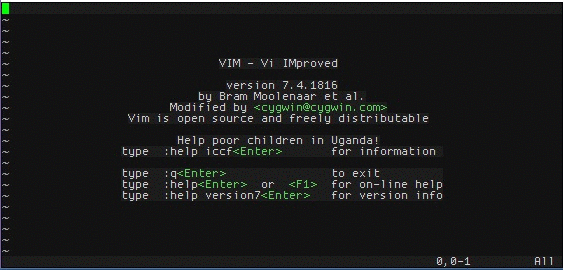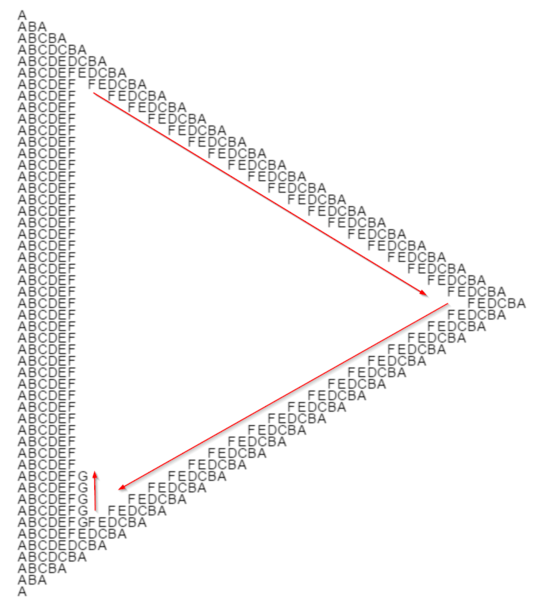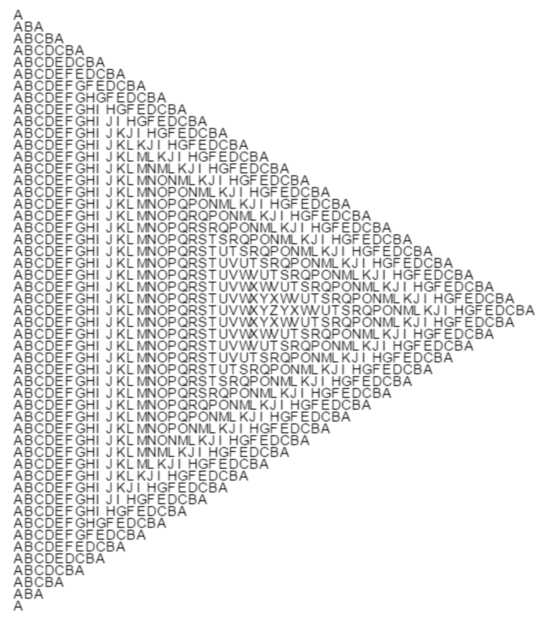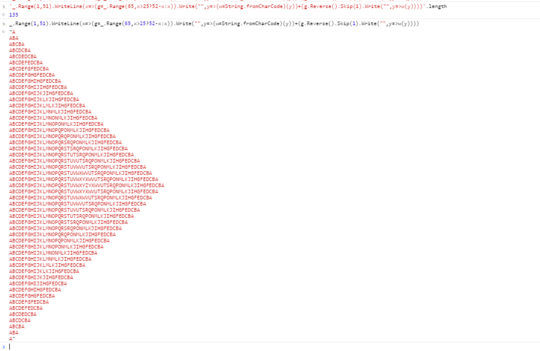49
10
You are to print this exact text:
A
ABA
ABCBA
ABCDCBA
ABCDEDCBA
ABCDEFEDCBA
ABCDEFGFEDCBA
ABCDEFGHGFEDCBA
ABCDEFGHIHGFEDCBA
ABCDEFGHIJIHGFEDCBA
ABCDEFGHIJKJIHGFEDCBA
ABCDEFGHIJKLKJIHGFEDCBA
ABCDEFGHIJKLMLKJIHGFEDCBA
ABCDEFGHIJKLMNMLKJIHGFEDCBA
ABCDEFGHIJKLMNONMLKJIHGFEDCBA
ABCDEFGHIJKLMNOPONMLKJIHGFEDCBA
ABCDEFGHIJKLMNOPQPONMLKJIHGFEDCBA
ABCDEFGHIJKLMNOPQRQPONMLKJIHGFEDCBA
ABCDEFGHIJKLMNOPQRSRQPONMLKJIHGFEDCBA
ABCDEFGHIJKLMNOPQRSTSRQPONMLKJIHGFEDCBA
ABCDEFGHIJKLMNOPQRSTUTSRQPONMLKJIHGFEDCBA
ABCDEFGHIJKLMNOPQRSTUVUTSRQPONMLKJIHGFEDCBA
ABCDEFGHIJKLMNOPQRSTUVWVUTSRQPONMLKJIHGFEDCBA
ABCDEFGHIJKLMNOPQRSTUVWXWVUTSRQPONMLKJIHGFEDCBA
ABCDEFGHIJKLMNOPQRSTUVWXYXWVUTSRQPONMLKJIHGFEDCBA
ABCDEFGHIJKLMNOPQRSTUVWXYZYXWVUTSRQPONMLKJIHGFEDCBA
ABCDEFGHIJKLMNOPQRSTUVWXYXWVUTSRQPONMLKJIHGFEDCBA
ABCDEFGHIJKLMNOPQRSTUVWXWVUTSRQPONMLKJIHGFEDCBA
ABCDEFGHIJKLMNOPQRSTUVWVUTSRQPONMLKJIHGFEDCBA
ABCDEFGHIJKLMNOPQRSTUVUTSRQPONMLKJIHGFEDCBA
ABCDEFGHIJKLMNOPQRSTUTSRQPONMLKJIHGFEDCBA
ABCDEFGHIJKLMNOPQRSTSRQPONMLKJIHGFEDCBA
ABCDEFGHIJKLMNOPQRSRQPONMLKJIHGFEDCBA
ABCDEFGHIJKLMNOPQRQPONMLKJIHGFEDCBA
ABCDEFGHIJKLMNOPQPONMLKJIHGFEDCBA
ABCDEFGHIJKLMNOPONMLKJIHGFEDCBA
ABCDEFGHIJKLMNONMLKJIHGFEDCBA
ABCDEFGHIJKLMNMLKJIHGFEDCBA
ABCDEFGHIJKLMLKJIHGFEDCBA
ABCDEFGHIJKLKJIHGFEDCBA
ABCDEFGHIJKJIHGFEDCBA
ABCDEFGHIJIHGFEDCBA
ABCDEFGHIHGFEDCBA
ABCDEFGHGFEDCBA
ABCDEFGFEDCBA
ABCDEFEDCBA
ABCDEDCBA
ABCDCBA
ABCBA
ABA
A
Specs
- Extra trailing newlines are allowed at the end of the output.
- Extra trailing spaces (U+0020) are allowed at the end of each line, including the extra trailing newlines.
- You can use all lowercase instead of all uppercase, but you cannot print partially lowercase partially uppercase.
- You can return the text as a function output instead of printing it in a full program.
Scoring
Since this is a triangle, and a triangle has 3 sides, and 3 is a small number, your code should be small in terms of byte-count.




22So many alphabets recently – downrep_nation – 2016-08-03T11:15:52.777
1My synesthesia is going hog wild, @downrep_nation – DoctorHeckle – 2016-08-03T13:33:34.977
5"Since a triangle has 3 sides and 3 is a small number, so your code should be small in terms of byte count." seems legitimate – Rohan Jhunjhunwala – 2016-08-04T22:00:52.653
1Squares of numbers composed only of 1 seems related: 11 = 1 ~= A , 1111 = 121 ~= ABA , 111*111 = 12321 ~= ABCBA ... – Caridorc – 2016-08-05T13:28:07.690
1"Since a triangle has 3 sides and..." Illuminati Confirmed. – HyperNeutrino – 2016-10-28T00:47:31.593